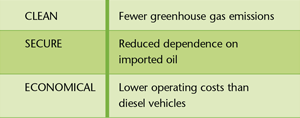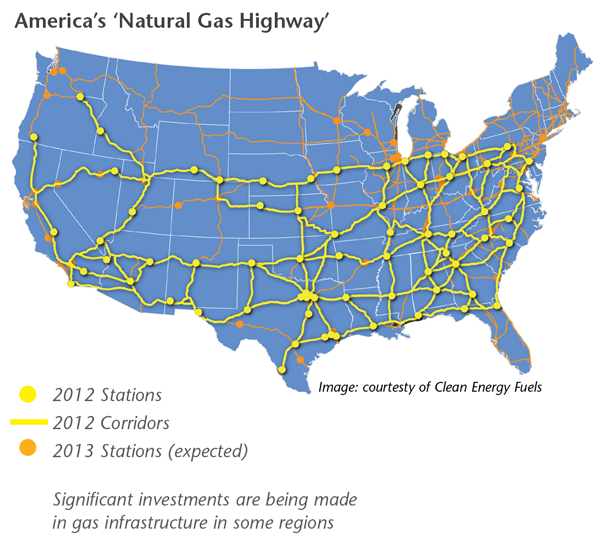Commercial vehicles
PC-12 on track for 2027
26 August 2025
Please note this article was published in May 2013 and the facts and opinions expressed may no longer be valid.
06 May 2013
Growth in the use of gas engines in transportation drives lubricant developments

Junhan Li, from the Infineum Large Engine Team, talks about the design of mobile gas engine lubricants and explains how a new tailored formulation, using salicylate technology, has gained OEM approvals.
It has been feasible for some time to use gas engines in mobile applications, like ships, trucks and buses.
However, the lack of a gas infrastructure means that until recently their use has been largely limited to stationary applications. But, with more gas coming on stream and with significant investments being made in infrastructure in certain regions, this picture looks set to change.
The real advantage of gas engines is their low emissions – something the whole world is looking for right now in mobile applications.
The use of natural gas in both liquid (LNG) and compressed (CNG) forms is emerging as an alternative to diesel fuel.
The fuel has a number of reported advantages over diesel or gasoline fuels in transportation applications. Not only is it in abundant supply, but also vehicles running on natural gas have lower operating costs and reduced greenhouse gas emissions compared with their diesel counterparts.

For these reasons governments around the world see gas as a particularly attractive option for public transportation.
A recent report from clean energy market research company, Pike Research, forecasts steady growth in the market for CNG and LNG trucks and buses. The analyst expects annual worldwide sales of these vehicles to more than double over the next seven years.
Pike says it expects growth in natural gas trucks and buses to be strongest in the Asia Pacific region. About three-quarters of the total natural gas trucks and buses are being sold in this region, a level that is not anticipated to change in the coming years.
Europe and North America are also anticipated to see strong growth, owing to the high costs of diesel fuel and increasingly strict government emissions restrictions.
In the US the lack of a gas infrastructure means the population of natural gas vehicles on the roads has been fairly constant over the last decade.
However, infrastructure investments are about to change things here. Natural gas fuel provider, Clean Energy Fuels, is reported to be building a network of 150 CNG and LNG fuelling stations at strategic locations along major trucking corridors to form the backbone of a national fuelling infrastructure.

The company expects that an increasing number of trucks powered by cleaner, cheaper natural gas will soon travel the country on ‘America’s Natural Gas Highway’.
This investment means gas engine sales could be poised for rapid growth – particularly in the heavy-duty arena as waste management, bus, and logistics companies convert their fleets to natural gas.
To tap into this growing market, the Infineum Large Engine Team has embarked on a number of projects in partnership with OEMs and oil companies over the last three years to develop gas engine oil (GEO) formulations specifically designed for mobile gas engines.
Oils designed for engines that are developed to run entirely on natural gas have very specific roles to play.

Diesel engine oil is typically formulated to handle soot and not nitration, and has a high Base Number (high ash) for acid neutralisation.
However, an oil for natural gas vehicles is formulated to handle nitration and oxidation and not soot. And, because gaseous fuel lacks sufficient lubrication/wetting property a balanced sulphated ash content is required to help prevent excessive valve wear.
Also, the higher combustion temperatures in CNG engines leads to higher oxidation, nitration and thermal stresses and this means diesel engine oils are not suitable for use in these engines.
The Infineum gas engine formulation is based on advanced salicylate additive technology.
One of the key factors when formulating a gas engine oil is striking the right balance for sulphated ash content. Too much and deposits can form, which can result in pre-ignition and valve torching; too little and insufficient acid neutralisation is provided, which means the valves are not sufficiently protected.
Calcium salicylates are industry-leading detergent components used in the formulation of top tier engine lubricants.
They provide strong acid neutralisation capability and prevent undercrown piston deposits. Infineum technology based on salicylate chemistry can deliver significant benefits over other detergent chemistries.
Working with an OEM in Asia, Infineum developed a lubricant using salicylate technology that was tailored specifically for their new CNG city bus engine.
Following a series of screener tests, the oil was subjected to a full field test in buses plying through a busy city centre. The oil achieved a 40,000 km drain interval and delivered the required level of protection to the engine. This performance resulted in factory and service fill approvals being granted by the OEM.
Gaining OEM approvals is an essential part in the commercialisation of a new technology.
Because Cummins is a major CNG engine manufacturer, Infineum was keen to gain the Cummins CES 20074 approval for the new gas engine formulation.
Collaborating with a local bus company and oil blender, five CNG buses used the new formulation over five 15,000 km drain intervals. Engine and oil data were collected at regular intervals and the results demonstrated that the oil provided maximum protection to the engine under severe operating conditions throughout the trial.
When presented to Cummins, these data prompted the OEM to award Infineum an approval for the technology.
The deployment of specially tailored gas engine oils for mobile application does not stop with these two projects. With local government driving the use of gas engines, more oil companies are interested in launching their own brand of gas engine oils. For the Infineum Large Engine Team this means moving on to the next partnership project.
Sign up to receive monthly updates via email
